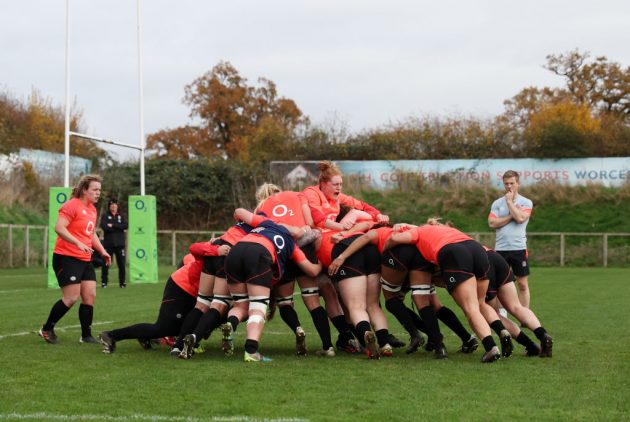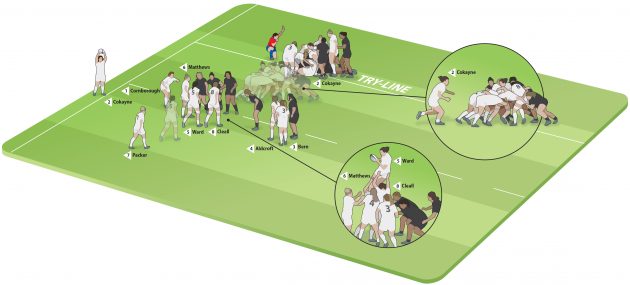Sean Holley gives his advice on mastering a difficult skill that the England women’s team make look easy
Red Roses Maul: How to power over from a driving lineout
The England women’s team is a fully pro, finely-tuned winning machine. The players look hungry, superbly conditioned and at one with a coaching unit headed by Simon Middleton.
The mark of last autumn’s wins over New Zealand was the 56-15 rout in the second Test at Franklin’s Gardens. The Black Ferns beat England in the 2017 Rugby World Cup final, scoring 41 points, but this is a different England.
There is a balance to their play that sees backs and forwards playing with tempo and adept at passing, offloading and getting into position with speed and precision.
The most impressive aspect of that series-clinching win over New Zealand was the set-piece. In particular, England’s meticulous lineout and the constant threat from the driving maul.
Forwards coach Louis Deacon is no stranger to the nuances of this part of the game, having come through Leicester’s ranks. He’s acutely aware of how the driving maul can not just impact the scoreboard but also its role in destroying opposition resistance, deterring them from even kicking to touch to give England lineouts. Their strength in this facet of the game has been evident throughout the Six Nations too.
Hooker Amy Cokayne scored three tries from driving mauls in the match against the Black Ferns at Northampton – a sure sign that England’s players and coaches have a clear understanding of what’s required.
Yes @amycokayne ???
A hat-trick for the England hooker off the back of more powerful lineout work ?#ENGvNZL | #RedRoses pic.twitter.com/x3HJnCe3sx
— England Rugby (@EnglandRugby) November 7, 2021
Here I’ve taken a closer look at her second try against New Zealand, which came just before half-time and broke the visitors’ resolve.
1. The Set-up
Props Vickii Cornborough and Sarah Bern stand at either end of the lineout. As potential primary lifters, this encourages New Zealand to mark up on them.
The actual lifting pod of Alex Matthews (front) and Poppy Cleall (back), and jumper Abbie Ward, arrive slightly later and execute the lift/jump before NZ have time to react.
Flanker Marlie Packer acts as scrum-half so she can be the first player onto the ball once Ward lands.
Coaching Points
Practise the lift and jump skills with and without competition. Hookers should practise throwing to different zones in the lineout; a coach, armed with a pole and catching net, can move to different positions in the ten-metre lineout span.

Ireland’s Rob Herring practises his lineout throwing by aiming at a hoop (Sportsfile/Getty Images)
The jumper, with elbows and hands high, can use her arms to help propel herself upwards and straight while the lifters clasp their binds to begin to lift.
Any motion forwards or backwards can affect the lift, so the jumper should focus on jumping straight to maximise the lift. She should have minimal dip at the knees, making it hard for opponents to read the play and to react.
Matthews and Cleall complete their lifts by manoeuvring Ward into the correct position and then cleverly shift beyond her towards the defenders to offer a buffer to the oncoming assault.
Related: How to lift at a lineout
2. The Delivery
After catching the ball, Ward turns towards her team-mates while still in the air and lands safely. Cornborough moves to Ward’s inside hip whilst lock Zoe Aldcroft, who was at the back of the lineout with Bern to act as a potential jumping option, moves swiftly to Ward’s outside hip.
Cornborough and Aldcroft now act as the second row of the formation, behind the front row of lifters Matthews and Cleall. Packer joins to take the ball from Ward. Bern binds onto Aldcroft for extra drive and Cokayne arrives to receive the ball from Packer.
Coaching Points
Both lifters must take care not to lose their bind for stability and not to get too far forward and thus risk being penalised for illegal blocking. They need to be tight so that New Zealand can’t get an arm through onto the ball or knock it to the floor.
The ball transfer is crucial – Packer and then Cokayne must be bound to the maul before receiving the ball to adhere to the laws.
In training, try disrupting this process by getting a ‘nuisance’ defender to move the lifters and another to get through any gaps to knock the arms of the lifters or get to the ball. This will test the solidity of the formation.
DOUBLE DOWN ??
England's lineout drive is too powerful and @amycokayne gets her second of the match ?
Second half incoming @BBCTwo ?#ENGvNZL | #RedRoses pic.twitter.com/yxrLVJXSEj
— England Rugby (@EnglandRugby) November 7, 2021
3. The Drive
England are now set to start driving. The back two rows are in lower body positions to enable a better forward thrust, much like in a scrum. The lifting pod stays compact and essentially forms an arrowhead that the rest of the players can push through to split the defence.
They also prevent an opponent from ‘swimming’ through the maul to get at the ball or ball-carrier. Cokayne has the ball well away from any threat and England can concentrate on staying tight and driving towards the line.
Coaching Points
Build this process with a ‘whole-part-whole’ method, especially if coaching younger players. Walking through the steps and breaking it down step by step, even without having the ball thrown in, is essential for learning and proprioception.
4. Keep the Shape
Those at the front work to keep the maul square. The second line keep their body angles and legs driving. Cokayne maintains a low body position and drives her legs, ball in one hand, bound to the maul with the other.
The force is too much for New Zealand, who defend individually to try to stop the maul propelling to their line.
Coaching Points
Communication is key. As the jumper, Ward is the most upright player and can see the shape of the maul. She can feel the weight of the resistance and the direction of NZ’s counter-attack. Teams will have calls regarding the need to shift the weight from one side to another or when to really ‘go’ if a defensive weakness is sensed.
Practise with varying resistance so the maul either halts or moves quickly forward. This instils decision-making and communication.
5. Try Time!
The precise formation and momentum of the English drive proves too much for New Zealand. Cokayne waits until the maul crosses the line and drops to the floor to score.
Coaching Points
Decision-making again is important in the final act of getting to the line. The hooker mustn’t get impatient and break away too early, especially if it’s a well-constructed maul. Likewise, the players in front of the ball. They must stay tight until the end to ensure the job is done.

Lark Davies breaks off a maul to score against Ireland in the Six Nations (Getty Images)
The practice of the maul in live situations, after players have learnt their roles and formation, is the only real way to learn of the pitfalls, legalities and physical effort required of this demanding skill.
Encourage feedback from each repetition and make the defensive team in practice value their roles in spending time on this aspect of the game. It will definitely pay off.
This article originally appeared in the May 2022 edition of Rugby World.
Download the digital edition of Rugby World straight to your tablet or subscribe to the print edition to get the magazine delivered to your door.
Follow Rugby World on Facebook, Instagram and Twitter.






